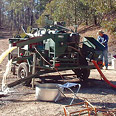All Articles
Legislative and Regulatory Update
March 2005 by Staff
• Changes to influential House committeesTwo legislators have moved into positions that will have an impact on current and future mining regulations.
Congresswoman Barbara Cubin (R-Wyoming) was named vice chair of the House Resources Committee. The Resources Committee handles matters related to natural resources, parks, public lands, mining and the environment.
Cubin joins chairman Richard Pombo of California as the committee looks to rewrite the Endangered Species Act, which will be an arduous task.
“There is not another committee in Congress that has a more direct impact on the every day lives of people in Wyoming,” said Cubin.
Representative Jim Gibbons (R-Nevada) was named chairman of the House Resources subcommittee on energy and mineral resources. He was a longtime member of the full committee, and served last year as vice chairman.
Gibbons is the only current member of the House with a degree in geology, which he obtained from the University of Nevada, Reno.
• Supreme Court may review ESA
A decision will likely have been made by the time you’re reading this on whether or not the US Supreme Court will hear a case involving six species of tiny bugs that halted a housing and commercial development near Austin, Texas.
The Endangered Species Act was instituted in 1973 using the Commerce Clause, which gives Congress the power to regulate interstate commerce.
The bugs have nothing to do with interstate commerce says the American Land Foundation, which has been funding the lawsuit. Dan Byfield, president of the American Land Foundation, stated, “There are six cave bugs that live in sinkholes on 120 acres of property. They are not traded. There is no commercial value. Little critters that live in a cave on private property cannot be regulated by Congress.”
Environmentalists are worried that losing this case could eliminate over half the species currently on the list of endangered species.
The plaintiffs were defeated in February 2004 at the US Court of Appeals, 5th Circuit, New Orleans. However, six of the sixteen appellate judges issued a strongly worded dissenting opinion, giving hope to the plaintiffs that they could be triumphant at the US Supreme Court.
Developers completed installing roads and utilities at their project back in 1988 when the government discovered the bugs on the property. The project has been stuck in limbo now for 17 years.
The case is GDF Realty Investments vs. Gale A. Norton, Secretary of the Interior. You can check the case status online at www.supremecourtus.gov/docket/03-1619.htm
• Suit filed to block Kensington
As expected, environmentalists have filed suit against the US Forest Service over its approval of the Kensington gold mine project near Juneau, Alaska, citing threats to endangered and threatened species and their habitat as reasons to block the project.
The appeal claims the Forest Service violated numerous laws and regulations when it approved the project.
• Exploration incentive proposed in Wyoming
The Wyoming House Revenue Committee approved a bill to create tax incentives for companies exploring for diamonds and other minerals unrelated to energy.
“Diamonds were discovered in Wyoming before they were discovered in Canada,” said Representative David Miller (R-Riverton). “This is the seed money that can grow into a huge mine.”
The bill would create an annual mineral severance tax credit for exploration equal to fifty percent of annual tax liability up to $100,000. A minimum of $40,000 would have to be spent on exploration in a county where mineral wealth is not being currently produced.
This may cause some problems if they do not define “production,” and we couldn’t find any such definition in the bill as it is written. If an operation is already producing miniscule amounts, would this void your ability to claim the credit in that county? This question has been forwarded to Representative Miller’s office for clarification.
• Montana bill LC1058
Montana Representative Gail Gutsche (D-Missoula) has introduced a bill in the state legislature that would impose additional restrictions and requirements on miners, including installing doors on tunnel openings, filing additional reports, obtaining operating permits for storing tailings, imposing civil penalties and changing reclamation requirements for placer miners and dredgers.
We would encourage interested parties to review draft bill number LC1058, also known as House Bill 0606, and let your representative know where you stand on it. You can find the bill online by searching www.google.com for “Montana bill LC1058.”
Gutsche’s email address, gutsche@wildrockies.org, may provide some insight on her attitudes toward mining. The wildrockies.org home page identifies it as “The Grassroots Activist Web Site for the Wild Rockies Bioregion.”

The Bawl Mill
• Before you invest your savings, ask to see their hands...
• Actual tax tips from the IRS for tax year 2008
• Maybe they thought the budget deadline was 2009?
Mining Stock Quotes and Mineral & Metal Prices
Industry Urges Restraint on Mining Reforms
Wyoming mining interests say the federal government doesn't need tougher environmental cleanup rules governing mineral extraction from public lands.
PLP Update
The miner was drywashing using a small, gas-powered drywasher for a short period of time—maybe an hour—when he was asked by a ranger to see his permit, which is not required to prospect at this small of a scale.
Using A Trommel For Placer Processing
 The behavior of a trommel is dependent on how it is designed and set up. Important design characteristics include feed rates, screen perforation sizes, cylinder size, rotation speed and incline.
The behavior of a trommel is dependent on how it is designed and set up. Important design characteristics include feed rates, screen perforation sizes, cylinder size, rotation speed and incline.
Subscription Required:
The Bawl Mill
• $100 Million Lost on Faulty ESA Listing
• Geologists Locate Giant Gemstones
• Miner Wins Important Victory Against Forest Service
• Philippines Asks Foreigners to Invest in Mining
• The Art of Finding Coarse Gold Part IV—Recovery of Coarse Gold From Alluvial Placers
• Healthy Interest at Recent Vancouver Conferences
• Idaho Silver Miners Come to Aid of Tsunami Victims
• Picks & Pans: In Search of a Vein: Looking for Hardrock in the Talkeetna Mountains
• Researchers Trace History of Hope Diamond
• The "Rip-Roaring" Flood That Washed Out Mazuma, Nevada
• Looking Back
• Resolution Copper Mine, Arizona
• Company Notes
• China Ups Investment in Foreign Minerals
• Melman on Gold & Silver
• Mining Stock Quotes and Mineral & Metal Prices
Free:








